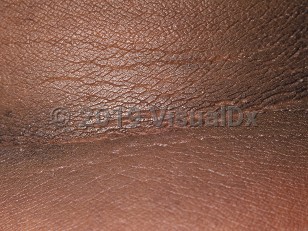Acanthosis nigricans in Adult
See also in: AnogenitalAlerts and Notices
Important News & Links
Synopsis

AN can be classified into 8 types:
I. Obesity-associated – Most common; linked to diabetes, insulin resistance, high body mass index (BMI), metabolic syndrome, and polycystic ovarian syndrome (PCOS).
II. Malignancy-associated / cutaneous paraneoplastic syndrome – Most commonly associated with gastric carcinoma, but numerous other malignancies have been reported. Elderly nonobese patients with new AN should have malignancy considered as a cause. Atypical (palmar, perioral, or mucosal) distributions or acute-onset AN may be more associated with malignancy.
III. Drug-induced – Niacin (nicotinic acid) is the most closely associated medication, but AN can also be caused by oral contraceptives, corticosteroids, diethylstilbestrol, heroin, fusidic acid, methyltestosterone, protease inhibitors, and folate.
IV. Syndromic – Type A refers to patients with HAIR-AN (hyperandrogenism, insulin resistance, and acanthosis nigricans) syndrome and acromegaly. Type B is typically seen in women who have uncontrolled diabetes mellitus and autoimmune diseases (systemic lupus erythematosus, scleroderma, Sjögren syndrome, and Hashimoto thyroiditis). This type is associated with the formation of antibodies against insulin receptors.
V. Acral – Affects elbows, knees, and knuckles. Typically seen in healthy sub-Saharan Africans.
VI. Unilateral – Also called nevoid. Usually represents an epidermal nevus in childhood.
VII. Benign – Rare autosomal dominant type developing at birth or during childhood.
VIII. Mixed – Any 2 or more of the above types combined.
Other related endocrinopathies include pituitary hypogonadism, thyroid disease, Addison disease, and acromegaly.
Codes
L83 – Acanthosis nigricans
SNOMEDCT:
402599005 – Acanthosis nigricans
Look For
Subscription Required
Diagnostic Pearls
Subscription Required
Differential Diagnosis & Pitfalls

Subscription Required
Best Tests
Subscription Required
Management Pearls
Subscription Required
Therapy
Subscription Required
Drug Reaction Data
Subscription Required
References
Subscription Required
 Patient Information for Acanthosis nigricans in Adult
Patient Information for Acanthosis nigricans in Adult- Improve treatment compliance
- Reduce after-hours questions
- Increase patient engagement and satisfaction
- Written in clear, easy-to-understand language. No confusing jargon.
- Available in English and Spanish
- Print out or email directly to your patient



